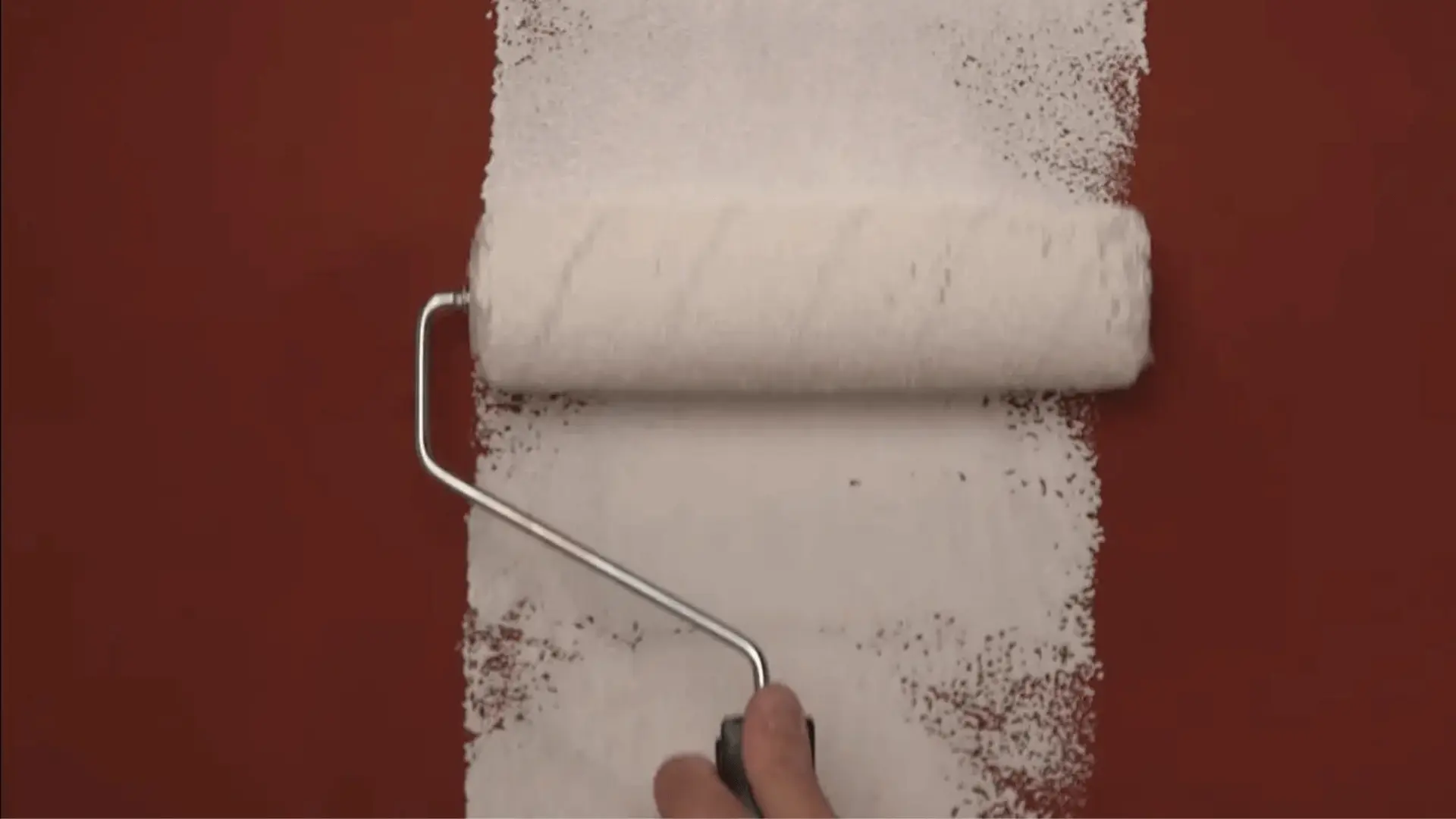Yes, you can apply silk paint over matte paint. First, clean and prepare the surface. Using a primer is recommended for better adhesion and to hide the matte finish. Test a small area to ensure compatibility.
Then, apply silk paint with proper tools and follow the manufacturer’s instructions. You may need multiple coats for the desired finish. Be sure to maintain and clean the surface properly for long-lasting results.
Here, you can see how to make work easier.
Characteristics of Silk Paint

Sheen Level: Silk paint is known for its moderate sheen level, which falls between flat or matte finishes and semi-gloss or high-gloss finishes. This sheen imparts a soft, satin-like appearance to the painted surface. It offers a balance between the dullness of matte paint and the high reflectivity of glossy paints.
Durability: Also, itis relatively durable and can withstand some moisture and cleaning without easily showing marks or damage. It is a good choice for areas that may require occasional wiping or cleaning, such as living rooms, bedrooms, or hallways.
Application: It can be applied to a variety of surfaces, including walls, ceilings, and woodwork. It is often used for interior applications but can be adapted for specific exterior projects when appropriate.
Versatility: Silk paint comes in a wide range of colors, and it can be used to achieve various decorative effects. It is suitable for creating a subtle, elegant look and is often chosen for spaces where a bit of luster is desired.
Cleaning: further, it is relatively easy to clean compared to matte paints but may not be as forgiving as high-gloss options. You can typically wipe down the surface with a damp cloth or mild cleaning solution without significant damage to the paint.
Surface Preparation: Proper surface preparation is essential when using silk paint. This includes cleaning, smoothing imperfections, and applying a suitable primer, especially when painting over previously painted surfaces.
Compatibility: It’s crucial to ensure that it is compatible with the existing paint or primer on the surface. Mixing paint types or sheen levels can lead to adhesion issues and an uneven finish.
Finish Options: Moreover, it is available in various finishes, such as soft-sheen or eggshell, which may vary slightly in their level of sheen. Choose the finish that best suits your project and desired look.
Brand and Product Variation: Different paint manufacturers offer it with varying formulations and features. It’s advisable to consult the product information and recommendations provided by the manufacturer for best results.
Maintenance: Like all paints, silk paint may require periodic maintenance and touch-ups to maintain its appearance over time. This is especially true in high-traffic areas or spaces with exposure to moisture or direct sunlight.
Characteristics of Matte Paint
Here are some key characteristics of matte paint:
- Low Sheen: Matte paint has very little to no gloss or sheen. It reflects minimal light, resulting in a flat and non-reflective surface. This characteristic gives matte paint a velvety, muted appearance.
- Absorbs Light: Unlike glossy or satin finishes, it absorbs light rather than reflecting it. This quality can help to hide imperfections on the painted surface, making it an excellent choice for walls with flaws or irregular textures.
- Aesthetic Appeal: Moreover, it is often chosen for its soft, elegant, and sophisticated appearance. It provides a smooth and understated look, which can create a sense of depth and warmth in a room.
- Hides Imperfections: Because of its low sheen and light-absorbing properties, it is effective at concealing surface imperfections, such as small dents, bumps, or minor cracks. This makes it a great choice for walls with less-than-perfect conditions.
- Texture Emphasis: Also, tends to highlight the texture of the underlying surface. This can be a desirable feature when you want to showcase the natural texture of a wall or artistic piece, such as canvas paintings.
- No Glare: One of the most significant advantages of matte paint is its lack of glare or shine. This makes it suitable for areas where you want to avoid distracting reflections, such as in home theaters or art galleries.
- Natural Colors: It retains the true and natural colors of the paint pigment. It does not alter or enhance the color in the way that glossier finishes might. This is why it’s often used when color accuracy is crucial.
- Less Stain Resistance: A drawback of matte paint is that it is less resistant to stains and scuffs compared to glossier finishes. It can be more challenging to clean and may require repainting in areas prone to heavy traffic and frequent touching.
- Limited Washability: Due to its vulnerability to staining and scuffing, it is not the most washable option. When cleaning matte-painted surfaces, it’s essential to use gentle methods and avoid abrasive cleaning products.
- Versatile Use: Lastly, it is commonly used on interior walls, ceilings, and artistic projects. It provides a cozy and welcoming atmosphere, making it suitable for bedrooms, living rooms, dining areas, and other spaces where a subdued appearance is desired.
Compatibility of Silk Paint Over Matte Paint
Applying silk paint over matte paint can be a viable option, but it’s essential to consider several factors to ensure compatibility and a successful outcome. Here are some key considerations:
- Surface Preparation: Proper surface preparation is crucial for good adhesion and finish quality. Begin by thoroughly cleaning the matte-painted surface to remove any dirt, dust, or contaminants. Use a mild detergent and water or a suitable cleaning solution to ensure a clean and smooth surface. Allow the surface to dry completely.
- Sanding: Depending on the condition of the matte paint, it may be beneficial to lightly sand the surface with fine-grit sandpaper (e.g., 220-grit). This scuffing helps to create a bit of texture on the matte finish, promoting better adhesion.
- Primer Application: Applying a suitable primer is often recommended when transitioning from matte to silk paint. A primer serves as a bonding layer, providing a better surface for the silk paint to adhere to. Choose a primer that is compatible with both matte and silk finishes. Latex-based primers are commonly used for such applications.
- Compatibility Testing: Before painting the entire surface, it’s a good practice to perform a small compatibility test in an inconspicuous area. Apply a small amount of it over the matte paint, following the recommended drying and curing times.
Check for adhesion, texture, and any adverse reactions. If the silk paint adheres well and the finish looks acceptable, you can proceed with the full application.
- Application Techniques: When applying the silk paint, follow the manufacturer’s recommendations regarding application techniques, including brush, roller, or spray application. Ensure even and smooth coverage, and pay attention to any differences in texture or appearance between the matte and silk areas.
- Multiple Coats: Depending on the color and opacity of the silk paint, you may need multiple coats to achieve the desired finish. Allow each coat to dry fully before applying the next.
- Drying and Curing: Allow the newly applied silk paint to dry and cure completely according to the manufacturer’s instructions. Proper drying and curing times are essential for the paint to reach its full durability and resistance properties.
- Finish Appearance: Be aware that the sheen and gloss level of the silk paint will differ from the matte paint underneath. The contrast between the matte and silk finishes may be noticeable, so be prepared for this change in appearance.
- Touch-Ups and Maintenance: In the future, if touch-ups or repainting are required, ensure that you use the same type and brand of silk paint to maintain consistency in finish and color.
Potential Issues and Considerations
Here are some key points to keep in mind:
- Adhesion Problems: One of the primary concerns is the adhesion of the silk paint to the matte paint surface. If the matte paint is exceptionally smooth or non-porous, the silk paint may have difficulty adhering. Proper surface preparation, including cleaning, sanding, and using a suitable primer, can help improve adhesion.
- Finish Appearance: The contrast in sheen and gloss between matte and silk paints can result in noticeable differences in the finish appearance.Also, silk paint will have a shinier, reflective quality compared to the flat, non-reflective nature of matte paint. This transition can affect the overall aesthetics of the surface and may not be desirable in all situations.
- Durability: Matte paint is known for its ability to hide imperfections, but it is less durable and less stain-resistant compared to some other finishes. The transition to it may impact the durability of the surface, making it more susceptible to scuffs, stains, and wear and tear.
- Color Variations: Some colors and pigments may behave differently when transitioning from matte to silk paint. The appearance and vibrancy of the color may change, so it’s essential to consider how the transition may affect the desired color outcome.
- Stain Resistance: Matte paint is less prone to showing stains, while silk paint may be more challenging to clean due to its higher gloss. Consider whether the area you’re painting is likely to encounter stains or dirt that will be more visible on a silk finish.
- Incompatibility with Underlying Issues: If there are existing issues with the matte paint, such as peeling, bubbling, or water damage, applying silk paint over it may not address or resolve these problems. It’s crucial to address any underlying issues before proceeding with the new paint.
- Surface Texture: The texture of the underlying it may affect the texture of the silk paint. If you want a completely smooth finish, you may need to do additional surface preparation and sanding to achieve this.
- Primer and Paint Compatibility: Ensure that the primer used is compatible with both matte and silk paints, and that the silk paint is suitable for the surface you are working on.
- Patch Test: Conduct a small patch test to assess the compatibility of the matte and silk paints in an inconspicuous area. This allows you to evaluate adhesion and finish quality before proceeding with the full application.
- Proper Drying and Curing: Follow the manufacturer’s instructions for drying and curing times for both the primer and silk paint. Proper drying and curing are essential for the longevity and performance of the new finish.
Steps for Applying Silk Paint Over Matte Paint
Applying silk paint over matte paint requires careful preparation and proper techniques to ensure a smooth and consistent finish. Here are the steps to follow:
Materials and Tools You’ll Need:
- Silk paint
- Primer (if recommended by the paint manufacturer)
- Paintbrushes or rollers
- Drop cloths
- Painter’s tape
- Sandpaper (fine-grit, e.g., 220-grit)
- Cleaning supplies (mild detergent, water)
- A bucket
- Rags or sponges
- Stir sticks
- Paint trays
- Painter’s mask (for safety)
Step 1: Prepare the Workspace
- Clear the area of furniture and other items to create a workspace.
- Cover floors and any remaining items with drop cloths to protect them from paint splatter.
Step 2: Clean the Matte Painted Surface
- Thoroughly clean the matte-painted surface using a mixture of mild detergent and water or a suitable cleaning solution. Remove any dirt, dust, and contaminants. Rinse the surface with clean water and let it dry completely.
Step 3: Sand the Matte Surface (Optional)
- If the matte surface is exceptionally smooth or non-porous, consider lightly sanding it with fine-grit sandpaper (e.g., 220-grit). This will create a slightly textured surface to improve adhesion.
Step 4: Tape and Protect
- Use painter’s tape to mask off any areas you do not want to paint, such as trim, moldings, or adjacent walls.
Step 5: Apply Primer (If Recommended)
- Check the manufacturer’s recommendations for both the matte and silk paints. If using a primer is recommended, apply a compatible primer over the matte paint. Use a paintbrush or roller and allow it to dry according to the manufacturer’s instructions.
Step 6: Stir the Silk Paint
- Open the can of silk paint and use a stir stick to thoroughly mix the paint. Ensure the color is consistent throughout.
Step 7: Paint the Surface
- Dip a clean paintbrush or roller into the silk paint and apply a thin, even coat to the matte-painted surface. Start at one corner or edge and work your way across the surface. Use a smooth and consistent motion to avoid streaks or lap marks.
Step 8: Allow the First Coat to Dry
- Follow the manufacturer’s recommended drying time for the first coat of silk paint. This typically takes a few hours, but it may vary depending on the specific product.
Step 9: Apply Additional Coats (if needed)
- Depending on the color and opacity of the silk paint, you may need to apply one or more additional coats. Allow each coat to dry fully before applying the next.
Step 10: Finish and Clean Up
- Once the final coat is dry, carefully remove the painter’s tape.
- Clean your paintbrushes, rollers, and any other tools with the appropriate cleaning materials.
- Dispose of used drop cloths and any paint waste properly.
Step 11: Maintenance and Aftercare
- After the paint has fully cured (which may take several weeks), follow appropriate maintenance guidelines for the silk finish, including cleaning and touch-ups as needed.
Maintenance and Aftercare

Maintenance and aftercare for paint can be easy and straightforward. Here are simple steps to follow:
- Regular Cleaning: Dust and dirt can accumulate on painted surfaces. To maintain the paint’s appearance, periodically wipe down the surface with a soft, damp cloth or sponge.
- Gentle Cleaning Solutions: If you need to remove stains or dirt, use a mild cleaning solution, such as a mixture of water and a small amount of mild detergent. Avoid abrasive or harsh cleaning agents that may damage the paint.
- Avoid Scrubbing: When cleaning, avoid vigorous scrubbing, especially on matte or delicate paint finishes. Gentle wiping or dabbing is usually sufficient.
- Touch-Ups: If you notice small areas with wear or damage, you can touch up the paint with the same type and color of paint. Follow the paint manufacturer’s instructions for touch-up applications.
- Preventative Measures: To minimize the need for maintenance, consider using protective measures such as furniture coasters, rugs, or wall hangings to prevent scuffs and damage to the painted surface.
FAQ’s
What happens when you paint silk over Matt?
Silk emulsion can look patchy when applied over matt emulsion if the surface is not properly prepared. Sanding down the wall before applying the new paint can help to smooth out any imperfections and create a more even surface.
Why can’t you paint matt over silk?
Matte paint has less sheen than silk, and applying it over silk paint can cause problems because matte paint is less flexible, leading to potential issues like shrinking and cracking, which can result in crazing.
Can you paint silk walls matt?
Yes, it is possible to paint matte emulsion over Vinyl Silk. However, it’s important to follow a few simple steps before applying matte emulsion over silk emulsion.
What can I put over matt paint?
You can protect matte paint by applying a clear acrylic medium (available in matte, satin, or gloss) followed by several coats of clear varnish. This provides protection against wear and dirt while allowing for restoration.
Is matt or silk paint better?
The main difference between matte and silk paint is their level of reflectivity. Matte paint has a less shiny finish, while silk paint has a higher sheen level and appears glossier. The choice depends on your desired finish and durability needs.
Why is my silk paint peeling?
Peeling paint can result from various factors, including painting over dirty walls, excess moisture, improper preparation, or using latex paint over oil paint, all of which can affect paint adhesion and cause it to peel over time.
Final Words
In conclusion, applying silk paint over matte paint is possible with the right preparation and steps. By cleaning the surface, using a primer, and ensuring compatibility between paint types, you can achieve the desired finish.
In addition, testing a small area is a smart approach, and multiple coats may be needed. Proper maintenance is essential to maintain the appearance over time. With attention to detail and following manufacturer guidelines, you can successfully transition from matte to silk paint, creating a new and appealing surface.











